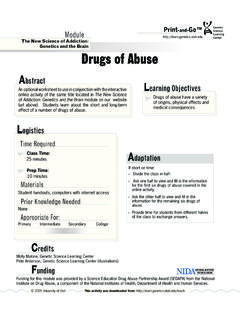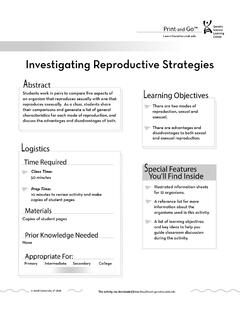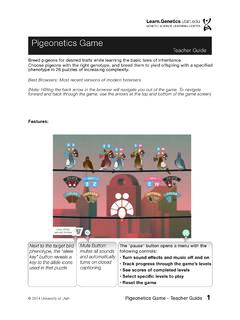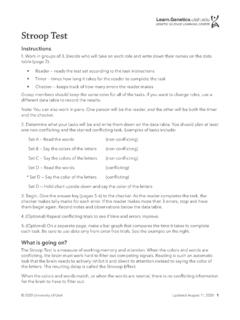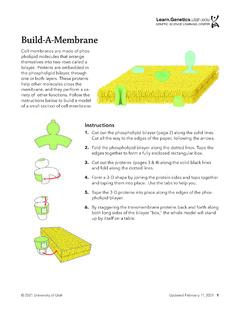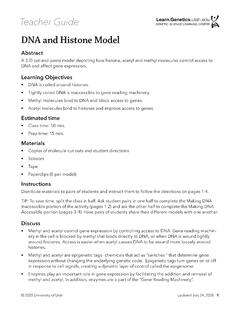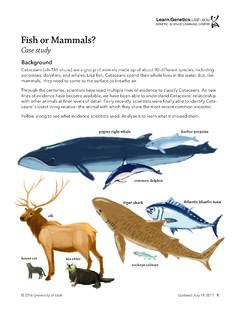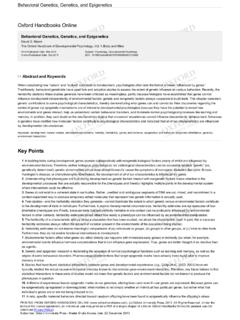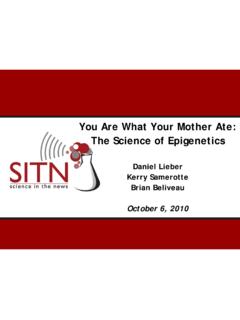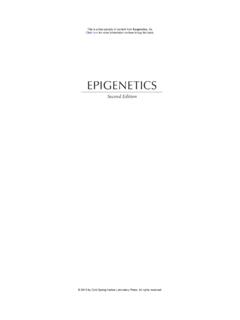Transcription of PRINT GO EPIGENETICS DNA and Histone Model
1 ADNA and Histone ModelE P I G E N E T I C S 2009 University of Utah PRINT -and-GO TIME REQUIRED Class time: 50 min. Prep time: 15 Copies of molecule cut outs and student directions Scissors Tape PaperclipsPRIOR KNOWLEDGE NEEDEDDNA, genes, cellular machinery reads genes and produces proteinsAPPROPRIATE FORLEARNING OBJECTIVES DNA is coiled around histones. Tightly coiled DNA is inaccessible to gene reading machinery. Methyl molecules bind to DNA and block access to genes. Acetyl molecules bind to histones and improve access to genes.
2 ABSTRACT A 3-D cut-and-paste Model depicting how Histone , acetyl and methyl molecules control access to DNA and affect gene Intermediate Secondary College BCLASSROOM IMPLEMENTATION ACTIVITY INSTRUCTIONSD istribute materials to pairs of students and instruct them to follow the directions on pages : To save time, split the class in half. Ask student pairs in one half to complete the Making DNA Inaccessible portion of the activity (pages 1-2) and ask the other half to complete the Making DNA Accessible portion (pages 3-4).
3 Have pairs of students share their different models with one POINTS Methyl and acetyl control gene expression by controlling access to DNA. Gene reading machinery in the cell is blocked by methyl that binds directly to DNA, or when DNA is wound tightly around histones. Access is easier when acetyl causes DNA to be wound more loosely around histones. Methyl and acetyl are epigenetic tags- chemicals that act as switches that determine gene expression without changing the underlying genetic code. Epigenetic tags turn genes on or off in response to cell signals, creating a dynamic layer of control called the epigenome.
4 Enzymes play an important role in gene expression by facilitating the addition and removal of methyl and acetyl. In addition, enzymes are a part of the Gene Reading Machinery .OPTIONAL MODIFICATIONS Introduce the following vocabulary for more advanced students: Nucleosome: a single Histone spool with its associated DNA. A sub-unit of chromatin. Chromatin: the material that makes up a chromosome. RNA Polymerase: the gene reading machinery Methyl attaches to DNA between a Cytosine (C) and Guanine (G) in locations known as CpG islands, where the frequency of C-G base pairs is higher than in other stretches of DNA.
5 Instruct students to look for CpG islands along the DNA ribbon when attaching methyl molecules and place them accordingly. You may also use different colored paperclips in place of the methyl molecule cut outs to better highlight the area where methyl attaches to DNA. Choose a region of the DNA ribbon to represent a gene. Have students color it with a highlighter before attaching the DNA ribbon to their Histone spools and winding. Ask students to visually keep track of the gene as they carry QUANTITIES PER GROUP OF 2: One copy of directions and molecule cut outs, pgs.
6 1-8. Scissors Invisible tape 8 standard size paperclips (No. 1, approx. 3 cm long) DNA and Histone ModelE P I G E N E T I C S 2009 University of Utah PRINT -and-GO the activity. Discuss how methylation and acetylation would affect the expression of the gene. Because Histone acetylation and DNA methylation are driven by constant cell signals, the physical structure of the genome is dynamic. Once they have constructed the Model both ways (Inaccessible DNA and Accessible DNA), have students portray the dynamic nature of the genome s physical structure by having them manipulate their models in response to gene on or gene off signals.
7 For example: Start with a constructed Inaccessible DNA Model . At the prompt of gene on have students acetylate their histones, de-methylate and unwind their DNA ribbons. At the prompt of gene off have students de-acetylate their histones, wind their DNA ribbons more tightly and add methyl. Discuss when a cell might receive such signals. EXTENSIONSMake a chromosome! Pool together the DNA and Histone models from the whole class, plus others if possible, and stack them. The models you pool can be tightly wound and methylated, loosely wound and acetylated, or a combination of both.
8 Be sure to connect the DNA ribbons to form one long, continuous strand. Students will see that chromosomes are made of DNA and histones. ACKNOWLEDGEMENTS This activity is a product of the 2008 Beyond the Central Dogma Master Teacher Summer was provided by a Science Education Partnership Award from the National Center for Research Resources, a component of the National Institutes of Health. PERMISSIONS Please see: to read our Permissions and Histone ModelE P I G E N E T I C S 2009 University of Utah PRINT -and-GO 2009 University of Utah NAMEDATEPRINT-and-GO DNA INACCESSIBLECut out all of the molecules on pages 5-8, assemble the DNA ribbon and Histone spools.
9 Gather 8 the cell, DNA is wound around spool-like molecules called histones. Attach one end of the DNA ribbon to a Histone . Fold one of the Histone tails over the DNA ribbon to help hold it in place. Secure it with a the remaining histones along the DNA ribbon at a distance of 2 strips of DNA apart (roughly 16 cm).Hold the first Histone upright in one hand. Wind the DNA ribbon clockwise around it roughly two times or until you bump in to the next Histone . Fold all of the Histone tails over the DNA ribbon to help hold it in to place and secure with a paperclip.
10 In a real cell, a length of DNA wraps around a Histone roughly times and Histone tails wrap around the wound DNA similarly. DNA and Histone ModelHow do molecules control gene expression? 2 2009 University of Utah NAMEDATEPRINT-and-GO not to fold or bend the DNA ribbon, wind it around the next Histone . Again, fold the Histone tails around the DNA ribbon and secure with a paperclip. Repeat until all of the DNA ribbon has been wound. The histones should begin to stack on top of one another as you wind. When DNA is wound tightly around histones, there tends to be a lot of methyl molecules bound to it.
